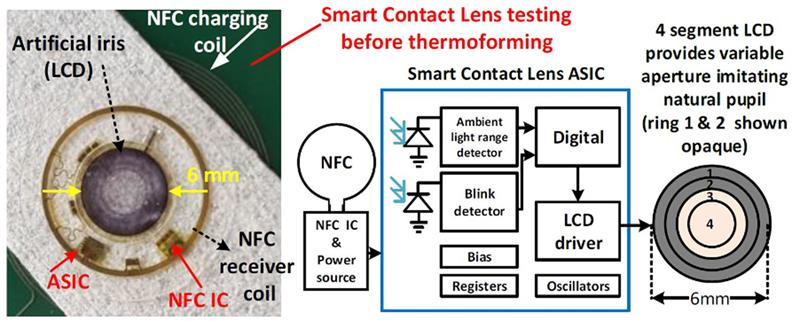The iris aperture can be tuned through concentric rings on an integrated liquid crystal display (LCD). The lens has been designed to operate for an entire day thanks to an ultra-low power design, offering a practical solution for people who suffer from human eye iris deficiencies like aniridia, high order aberrations like keratoconus, and light sensitivity or photophobia.
The first performance assessment of the artificial iris - which appears in Scientific Reports from Nature - demonstrated its potential to expand the visual sharpness, decrease optical aberrations and reduce the amount of light entering the eye in a dynamic manner. The prototype will be further developed into a medical device within the framework of the spin-off incubation initiative Azalea Vision, from imec and Ghent University.
The human iris controls the pupil size in response to light, regulating the amount of light that reaches the retina. Patients suffering from human eye iris deficiencies like aniridia, higher order aberrations like keratoconus, and light sensitivity or photophobia, which is highly prevalent in patients with chronic migraine, and Dry-Eye Syndrome (DES) could use this platform inside a contact lens. The prevalence for these groups adds up to more than 20 million patients.
Current solutions such as contact lenses with a fixed iris, artificial iris implants or glasses with variable transparency, do not entirely mimic the normal functionality of the iris. For example, they do not affect the depth-of-focus, hence impeding a sharp vision. The artificial iris lens is capable of dynamically changing the pupil size, bringing back two levels of functionality of the eye, being light adaptation and expanded depth-of-focus.
Currently the Azalea Vision team is focused on validating this device with patients and volunteers under clinical investigations in order to provide a functional, robust and safe device for diverse eye disorders with light sensitivity and lack of visual sharpness.
“The Azalea Vision initiative adds to our longstanding track record of creating spin-off’s in the photonics and microsystems area”, said Rik Van de Walle, rector of Ghent University. “Many of these new companies target important medical problems and several more start-up initiatives are in preparation.”

“By combining our expertise on miniaturised flexible electronics, low-power ASIC design and hybrid integration, we have demonstrated the capacity to develop a solution for people who suffer from iris deficiencies, higher order aberrations and photophobia, a common yet debilitating symptom seen in many neuro-ophthalmic disorders”, says researcher prof. Andrés Vásquez Quintero at imec/UGent. “Our smart contact lens can control the level of incoming light mimicking a human iris and offering a potential solution to vision correction – by expanding depth-of-field with automatic control of pupil size. This way, our approach can surpass current solutions to combat human eye iris deficiencies. Its beneficial optical effects will be further clinically validated and developed into a medical device.”













